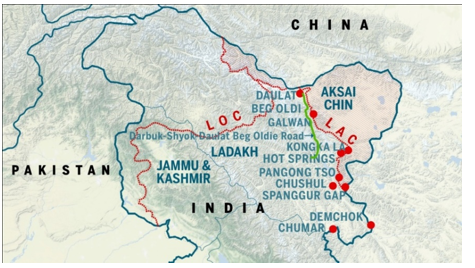

14th January 2025 (13 Topics)
Context
The LAC has been the site of rising tensions between India and China, particularly since April 2020. General Upendra Dwivedi, the Chief of the Indian Army, mentioned that although there is a “degree of standoff” along the LAC, the situation is “sensitive but stable”. His statements shed light on the evolving military dynamics, specifically concerning ongoing border standoffs, engagements, and security concerns at multiple points along the Line of Actual Control (LAC) and Line of Control (LoC).
Important Locations
- Siliguri Corridor (Chicken’s Neck): The Siliguri Corridor is a narrow land passage that connects the northeastern states of India to the rest of the country. Despite its perceived vulnerability, it is actually India’s strongest strategic point.
- Doklam: Doklam is a tri-junction area near Bhutan, where India, China, and Bhutan meet. China’s construction of infrastructure in the region has been a matter of concern for India, as it brings the two nations into closer proximity.
- Depsang Plains: The Depsang Plains are located close to the strategically important Daulat Beg Oldie.
- The crucial Sub-Sector North (SSN) consists of the Depsang plains and Daulat Beg Oldie (DBO). Currently, the airfield at DBO is accessible by the 255 km-long Darbuk-Shyok-DBO (DSDBO) road.
- Depsang is also close to the Karakoram passoverlooking the strategic Saltoro ridge and Siachen glacier, the world’s highest battlefield.
- The Depsang Plains issue began in 2013 when China carried out an 18-km incursion in the area.
- Demchok: Demchok is in the southern part of eastern Ladakh. In Demchok, the problem is mainly at the Charding Ninglung Nullah (CNN) junction.
Fact Box:What is LAC?
What is LOC?
Key Differences
|
More Articles


